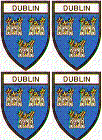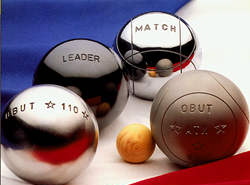|
No two Petanque piste/terrains play the same, as so much depends on its construction, however several points are important.
The Dimensions
A piste needs to be 3 metres wide and 12 metres long (4 metres x 15 metres if you have the room). Games are played over distances from 6 to 10 metres and at various angles.
The surface is important
A loose surface such as gravel or shell (10--20 mm) is preferred since it tends to stop the boules from rolling too far. The actual construction depends much on the site and finance available.
The steps involved
1. Checking the site dimensions, drainage etc.
2. Removing grass (or other existing surface).
3. Removing loose soil.
4 Defining the boundary.
5 Adding the base course, compacting and rolling.
6 Adding the surface layer.
1. Site dimensions and drainage etc.
The dimensions should be multiples of (12m x 3m) and need not be in a single rectangular or contiguous area (as long as each 12 x 3 m area is contiguous).
It is important to ensure adequate drainage. To do this dig a trench deep enough to create a fall from the terrain to the outlet. Lay in drainage pipes or a soak hose, cover with gravel and back fill with top soil.
2. Removing grass or other existing surface
It is important to remove all vegetation when forming your terrain. It is also important to remove all boulders or other protruding objects. It is preferable to "scrape" the surface (either manually or mechanically) so as not to disturb the firm base/subsoil.
3. Removing loose soil
All loose soil should be removed as detailed above. Once removed, the area should be sprayed with an all purpose weedkiller and covered in weed-mat to prevent regrowth.
4. Defining the boundary
Defining the boundary can be as simple as where the terrain meets the surrounding grass or can be defined by string or some more permanent structure. Try and avoid something solid like bricks as they can damage the boules if hit directly. Punga logs if available make a natural edging that will last well.
5 Adding the base course, compacting and rolling
The most important aspect of the base course, is not its composition but that it is well compacted. It will be almost impossible to manually compact it sufficiently and it is highly recommended that a mechanical compactor be used.
6 Adding the surface layer
If you have done a proper job in the preparation of the terrain your choice of surface layer is almost immaterial. A nice looking finish is obtained through the use of 10-20mm of cockle shells although "metal fines" make for an excellent alternative. You could also finish different pistes with different surface layers, thereby adding to the challenge and the experience of playing on different surfaces.
|

